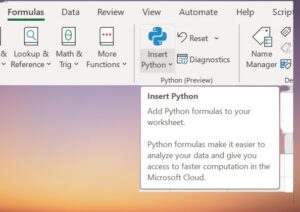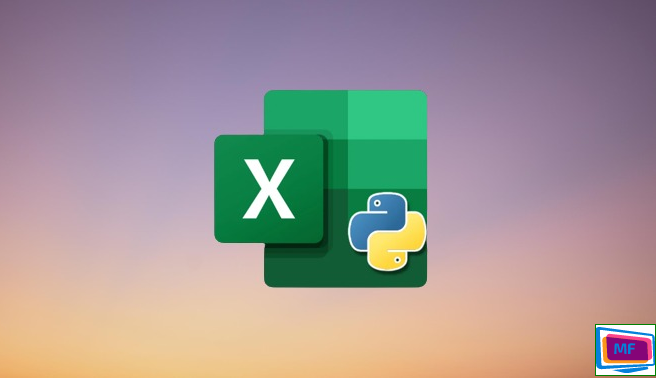Announcing Python in Excel : Combining the power of flexibility Python and the Excel
Providing a major boost to its analytical capabilities, Microsoft on August 23 Announcing Python in Excel that it is bringing Python to Excel through a Public Preview.
Microsoft collaborate with data science platform ANACONDA to bring this feature to life. the company is using well known Anaconda python distribution libraries running into Azure.to bring the most popular and powerful Python Libraries to excel.
Since its inception Microsoft Excel has revolutionized how people organize, analyze and visualize data. It serves as a foundation for decision making for millions of users every day. Today we are thrilled to unveil an evolution in Excels capabilities by releasing a Public Preview of Python integration.
In a move that bridges spreadsheet software and programming worlds Microsoft presents its innovation; a direct integration, between Python and Excel. These enhancements are set to transform how users interact with data by allowing them to leverage the power of Python within their environment of Microsoft Excel. With these two tools working together seamlessly Microsoft empowers users to take their data consumption, analytics and automation to levels of excellence..
Announcing Python in Excel:

Announcing Python in Excel
For decades Excel has been the cornerstone of data management, making it easy to use for tasks ranging from simple calculations to complex data analysis while Python has emerged as the most popular programming language it is known as one of the most versatile and easy to use.
Python in Excel makes it possible to natively combine Python and Excel analytics within the same workbook – with no setup required. With Python in Excel, you can type Python directly into a cell, the Python calculations run in the Microsoft Cloud, and your results are returned to the worksheet, including plots and visualizations.
Adding Python to Excel brings with it countless possibilities. This allows users to perform complex tasks that were previously difficult or even impossible only in Excel. Whether it’s statistical analysis, machine learning projects, or data visualization, Python’s extensive ecosystem of libraries opens up a world of opportunities.
Advanced Visualizations
To bring the most popular Python libraries to Excel, including the likes of Matplotlib and seaborn for data visualization. spanning from conventional bar graphs and line plots to specialized visualizations such as heatmaps, violin plots, and swarm plots.
Additionally, the integration of Python with Excel increases the productivity capabilities of spreadsheets. Python’s scripting prowess enables users to automate common tasks, streamlining data processing and saving valuable time. This interface between the most widely used and mainstream programming languages.
In native Python integration with Excel, users will be able to use the new PY function to input Python code directly into Excel cells.
Unveiling the Power of Python: Exploring Its Best Features
In the dynamic world of programming languages, Python has emerged as a true powerhouse, captivating developers with its simplicity, versatility, and efficiency. With a plethora of programming languages to choose from, what sets Python apart are its exceptional features that cater to beginners and experts alike. Let’s dive into the key features that make Python a standout language for various applications and industries.

Announcing Python in Excel
Readability and Simplicity
Python’s syntax is renowned for its readability and simplicity. The language’s minimalist design emphasizes code clarity, making it easy for developers to express concepts and ideas without unnecessary clutter. This feature is particularly advantageous for newcomers to programming, as it reduces the learning curve and allows them to focus on problem-solving rather than intricate syntax.
Extensive Standard Library
Python boasts an extensive and robust standard library that offers a wide array of modules and functions, eliminating the need for developers to reinvent the wheel. From handling file operations to working with data structures, the standard library covers an extensive range of tasks, empowering developers to expedite their projects by leveraging pre-existing solutions.
Cross-Platform Compatibility
Python’s cross-platform compatibility allows code to run seamlessly on various operating systems without modification. This versatility is a significant advantage, as it enables developers to build applications that cater to users across different platforms, expanding the reach and impact of their creations.
Dynamic Typing and Automatic Memory Management
Python’s dynamic typing frees developers from declaring variable types explicitly, enhancing flexibility and speeding up the development process. Additionally, the language incorporates automatic memory management, handling memory allocation and deallocation, which reduces the risk of memory-related errors and improves overall program stability.
Rich Ecosystem of Frameworks
Python’s popularity has given rise to a vibrant ecosystem of frameworks tailored for diverse applications. Whether you’re working on web development, data analysis, machine learning, or scientific computing, there’s a Python framework available to streamline the process and accelerate your project’s development.
Community and Documentation
The Python community is renowned for its warmth, inclusivity, and dedication to helping fellow developers. This supportive atmosphere fosters collaboration, knowledge sharing, and the creation of open-source projects. Furthermore, Python’s extensive documentation serves as an invaluable resource for developers at all levels, offering clear explanations, examples, and guidelines for effective coding.
Rapid Prototyping and Development
Python’s concise syntax and easy-to-use features make it an ideal choice for rapid prototyping and development. The language’s quick turnaround time allows developers to swiftly transform ideas into functional prototypes and iterate as needed, enabling efficient testing and refinement of concepts.
Strong in Web Development
Python’s prowess extends to web development, with frameworks like Django and Flask providing the tools to create dynamic and interactive web applications. These frameworks leverage Python’s simplicity and modularity, enabling developers to build feature-rich websites with relative ease.
Support for Scientific and Numeric Computing
Python is a go-to language for scientific and numeric computing, thanks to libraries like NumPy, SciPy, and pandas. These libraries offer powerful tools for data manipulation, analysis, and visualization, making Python an essential tool for researchers, data scientists, and analysts.
Versatile Application Range
Python’s versatility is one of its standout features. From web development and data science to automation and artificial intelligence, Python finds its application in almost every corner of the technological landscape.
